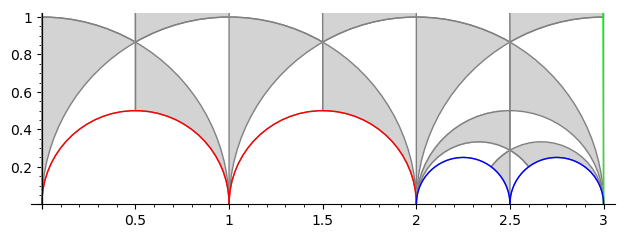Group given by congruence relation
Hi,
Beginner in Sage (I love it!) , I want to ask you this maybe naive question:
I have a group $G$ defined by $\lbrace M \in SL_2(Z) \ | \ M = I + kB \ mod(N) \rbrace $, where $I$ is the identity, $N$ a given positive integer, $B$ is a given fixed matrix verifying $B^2 = 0$ and $k$ (not fixed) any integer in { 0,1,2,....,N-1 }. I want to explore conjugacy classes/subgroups of this group $G$ for some specific $B$ and $N$. Is this subgroup finitely generated for some $N$? subgroups of finite index? etc... Do I have a way to do that with SageMath?
Remark that
It is subgroup of a finitely generated group butv that do not imply that it is finitely generated
$B^2 = 0$ gives that $I + kB = \Lambda^k \ with \ \Lambda = I + B$.
An obvious subgroup is $ H = \lbrace \Lambda^k, \ k \in \mathbb Z \rbrace$
Any advise or web pointer would be appreciated
Thanks for your help



Why is it a group?
Hi,
Thanks for your interest in my question . Here is the argument
Essentially because $B^2 = 0$.
Just to be clear, saying that $A=B \ mod(N)$ means that $A - B = N \cdot X$ where $X$ is an integral matrix
1) $I \in G$, take k=0
2) Take $A = I + mB + N\cdot X, B = I + nB + N\cdot Y\in G$ , $X,Y$ being any integer coefficients matrices. Write the product and you will see that (because $B^2=0$) we have $A \cdot B = I + (m+n)\cdot B \ mod(N)$
3) For the inverse, you see easily that if $A = 1 + k \cdot B \mod(N)$ then $A^{-1} = 1 - k \cdot B \ mod(N)$
So k is not fixed, you should make it clearer in your question.
With this definition, it is the preimage of a subgroup under the reduction mod N:
SL(2,Z) -> SL(2,Z/NZ). Hence it is finite index inSL(2,Z)and in particular finitely generated. It is also congruence as it contains Gamma(N).Yes sorry for that, you are right, fixed. Great thanks for this point of view, gives me a step further.
Yes , in fact $G \cap \Gamma_0 = \Gamma(N)$